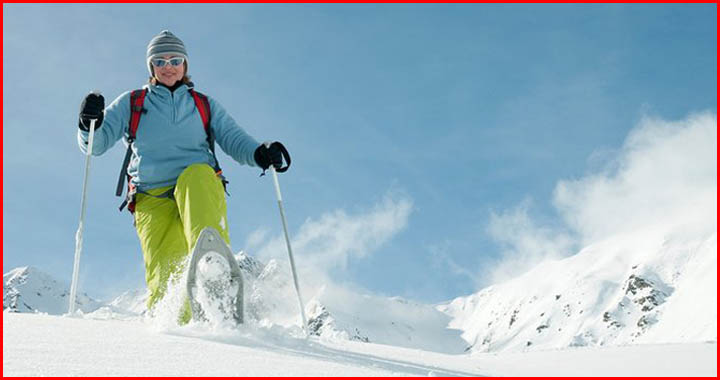Snowshoes are not just what you need when you venture into snowshoeing. It’s best to check out what to wear for snowshoeing to prep yourself before you head on the trail.

Since you’ve made it to this post, I’d assume you already have a pair of great snowshoes. Now all that’s left is getting prepared for the real winter adventure. That includes learning about what to wear and what to bring in your first snowshoeing hike. Such is important because what you’ll be wearing out there on the trail may determine whether you’ll have a good time or not.
Tips on How to Dress for Snowshoe Outing
With the weather keeps being uncertain these days, it’s always best to put on your outfit in layers. That’ll allow you to adapt to the changing conditions quickly, either by adding or removing a layer. Moreover, since you’re bound to sweat while snowshoeing (trust me, you will!), you’d better arm yourself with base layers made of moisture-wicking materials. Generally, it’d be either synthetic or wool; but never wear cotton. The latter is capable of absorbing sweat quickly, but it takes longer to dry. When wet clothes meet chilly winter air, you’ll get yourself an uncomfortable icy cold feeling.
What to Wear for Snowshoeing?
Do note that snowshoeing is a whole lot tougher for your heart than it looks. It’s safe to say that it’s an intense cardio workout. By knowing that, you will not want to put on too many layers right off the bat (unless it’s unusually cold). Otherwise, you’ll get toasted and all sweaty inside after just 15-20 minutes of walking. It’s best to dress lightly. You’re going to feel a bit cold on the trailhead, but after making the first few steps your body temperature will rise up quickly. Here’s how your snowshoeing outfit should consist of:
- Base layer: This layer is supposed to keep you warm. Make sure you choose the most comfortable one.
- Long underwear top and bottoms
- Synthetic or wool socks. Bring 2-3 spares. You’ll never know when they’ll get wet because of the snow.
- Insulated layer: It’s the removable layer. You can take it on and off depending on how warm you are on the trail.
- On the top: fleece jacket or wool sweater.
- On the bottom: wear fleece pants.
- Outer layer: This is the layer that keeps you from getting wet. Put this on if it’s snowy or if you’re planning to go through deep powder.
- Waterproof softshell jacket or insulated parka
- Waterproof softshell pants
- Footwear: You can either wear waterproof hiking boots or winter boots suitable for outdoor use, like Sorel and Columbia. Check out these great boots!
- Waterproof hiking boots are ideal since they’re lightweight. Their soles are flexible too, and the upper is often breathable, making them much more comfortable than winter boots.
- Winter boots are only good if the days are extremely cold or if you’re on a short hike. The removable insulation layers inside them are better at preserving the warmth. The soles are stiff, and they can be pretty heavy. I won’t wear them if I plan to be on the trail for long.
- Accessories: They’re the little essentials that may seem unimportant, but you won’t be able to forgive yourself if you forget to bring them with you.
- Wool or fleece hat. Make sure you choose one that covers your ears too. Always bring spares.
- Waterproof gloves. When it’s colder than usual, wear mittens. Bring spares for this one too.
- Gaiters to keep snow away from your boots upper.
- Sunglasses, because the snow can be quite blinding if it’s sunny.
- Small day pack: This is used for other necessities, which include the following:
- Water. You’re going to need around 16 oz of it for every hour you spend on the trail.
- Snacks and lunches. Did you know that snowshoeing burns 420-1000 calories per hour? Yes, that’s a fact. So, bring some hearty meals with you!
- Sunscreen. So, you won’t get burned when it’s sunny.
- Binoculars or camera or your smartphone for sightseeing. Make sure you bring a protective case too (ziplock bag will do) to protect them from moisture.
- Adjustable poles. When the going gets tough and steep, you’ll thank yourself for bringing them along.
- First-aid kit. For snowshoeing, the kit should include duck tapes (useful in case of sprained ankles and wrist), ziplock bags (to create ice packs using snow), emergency blankets, and other usual items.
- Safety gears. They include a headlamp or a flashlight, a map of the respective area, a compass, a whistle, and waterproof matches.
Remember to study the map before you set off. Make sure you can quickly locate the nearby resources, such as the resorts, ranger stations, or even mountain huts. If you bring your smartphone, be sure to pack an extra battery with you. Don’t forget to save the phone numbers of nearby resources. Cellular service is usually scarce, especially if you break off trails, but it never hurts to have those numbers in your handheld. Last but not least, always inform someone where you are going, through what route, and how long you intend to be there.
You Might Also Want to Read These:
